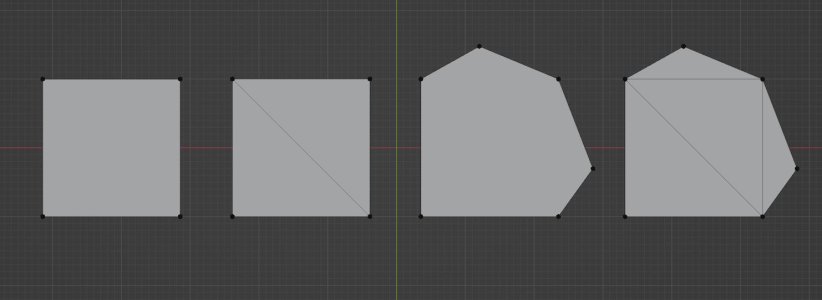You'll have a good grasp on the basics. Though to be blunt, I'd say the real experience comes from fucking things up by accident, learning how to fix them, then understanding how to avoid said fuckups later.
You mean the underlying mesh topology? To overly simplify, yeah, they're both the same in that regard. In Blender, you'll generally be working with quads, though it can handle tris and ngons. Unreal, and by extension all realtime 3d engines, will everything you do to tris, which are quads that have been cut in half.
For example...
View attachment 11243
That's a quad on the far left, or a polygon with 4 vertices. Next to it are two tris, a tri being a polygon with 3 vertices, which is what Unreal will turn your quads into when you import it. Next to that is an ngon, which is a polygon with x amount of vertices. And next to it is the ngon converted to tris, which once again, is what Unreal will turn it into.
Now I could go into the pros and cons of modeling with each, but topology in general is a subject that could fill at least three books. To cut it down to the bare basics, you want to stick with quads when modeling because they're predictable. You can look at them and see how they flow. You can run loop cuts through them, bevel them, slide them, and do all other kinds of adjustments to them without any concern of them going squirrely on you. Plus, they subdivide cleanly, which is something you'll get into with the Day 2 tutorials.
Now that isn't to say you shouldn't ever use tris or ngons, but understanding the best use for them, when you can use them, and when you can get away with them, is something you'll pick up on once you gain a bit more experience.
You can do basically whatever you want to in Blender. See, you can make hills, mountains, and valleys in Unreal, but you're really only limited to pushing verts up and down. You can do that in Blender as well, but you can also work on the axes, moving things left and right, overlapping bits and pieces. There's no limitation on that front.
If you want to, you could even sculpt, which would cover your rock cliffs. Though you'd need to learn how to bake and retopologize, because when you're sculpting, you're working with millions of polygons, which will drag down your performance if you popped your sculpted object into Unreal as is.
...unless you're using UE5, where polycount is no longer such a big deal.
Anyway, I'd get into more, but I wanna eat my lunch.





